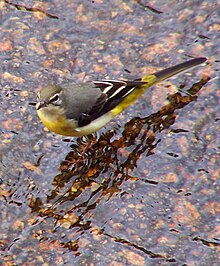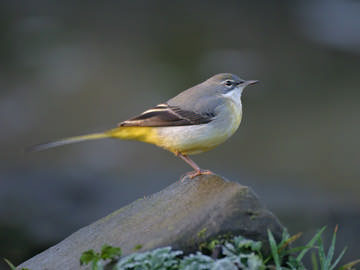Grey Wagtail
Female Grey Wagtail (Motacilla cinerea)
The Grey Wagtail (Motacilla cinerea) or Grey Wagtail is a Singvogelart from the family of Wagtail ( Motacillidae ). The very long-tailed, upper side gray and bright yellow hand Stilt settled fast flowing, mostly wooded waters and feeds mostly on insects and their larvae. They often breeds on weirs, bridges and mills. The range extends from the islands of the eastern Atlantic and the Atlas Mountains in North Africa over large parts of Eurasia, where the species, however, is largely absent in North Europe, the European part of Russia and large parts of Central Asia. Most wagtails of the Atlantic influence in Europe and the subtropical regions are resident birds, northern breeding populations and most Asian birds winter in the subtropical and tropical regions of Europe, Africa and Asia. The species has spread since 1850 of the Central European low mountain ranges of the North German Plain and to Poland and from there developed new breeding areas in the Netherlands, Northern Europe and the Baltics. In the mid-20th century, the stocks fell sharply there, seem to have but since recovered. The species is not endangered according to IUCN.
Description
The wagtail is about the size of a wagtail, with 9-10.5 cm but slightly long-tailed and slender with about 17-20 cm body length. The wing length is between 80 and 89 mm. The black beak measures 15 to 17 mm, the legs and feet are flesh-colored horn-colored to brownish. The hind claw is quite long and curved. The iris is dark brown, the eye shows a white ring.
In the male of the nominate the top is in breeding plumage to the back cool gray and tinted light greenish brown in fresh plumage. About The narrow eye-streak is white, the reins dark gray to black. The throat is black at the top by a strong chin stripe of the gray top isolated. The rump and upper tail-coverts are greenish yellow and sides pure yellow like the under tail-coverts, which are particularly intense color. The rest of the underside is also predominantly yellow, but brightened whitish edge to the middle and sometimes also over gray wash. The edge blankets are gray like the top, the other upper wing-coverts are lined with black gray and lighter gray. The wings are colored similarly, but show a white area that is not noticeable when folded wings in flight but as a white wing band is visible at the bases of the inner hand and the arm swing. This can clearly be seen on the wing underside. The shield feathers are blackish and edged with white to beige white. From the light gray under wing-coverts carry the longest white lace. The middle three control pairs of springs are black and lined partly greenish yellow in fresh plumage, the outer three predominantly white and only the two inner black at the base to one part.
The female in summer dress is similar to the male. Most throat in contrast to that of the male is whitish, in many individuals is also found washed-out black at the edges and in some, few throat is completely black. The underside is usually less vivid yellow, the flanks often extensive white.
In winter dress also the males lack the black of the throat, this is then often somewhat reddish beige, as well as the yellow breast may be slightly reddish beige wash over and over eye-streak is more beige. In contrast to females in winter plumage bright throat is usually sold out clearly to the chest. In the female, also the ear-coverts, the supraorbital stripe, throat and chest, the yellow of the underside are tinted beige stronger and lighter in color.
The juvenile plumage resembles the winter plumage of the female, but the head part and the back brownish and brighter, the supraorbital stripe are often indistinctly pronounced and flesh color of the lower mandible. Some individuals show a diffuse spot on the neck or belt. The chest is mostly about washing isabellfarben, the rest of the underside whitish to pale yellow on the under tail-coverts. The greenish yellow of the rump is less extensive than in the adult birds.
Birds in first winter show is still very much beige on the head and chest and yellowish underside is often not quite fully colored. The transitions to adult apparel are but fluent. In the first breeding plumage young wagtails can no longer be distinguished from adult animals in the field.
Voice
The reputation of the wagtail is a hard, metallic " zitzitt " or " zezeze "
Geographical variation
- M. c. cinerea Tunstall, 1771 - Europe, North Africa and Asia Minor to the Caucasus and southward to the northern and southwestern Iran
- M. c. melanope Pallas, 1776 - North Asia from the Urals to the Sea of Okhotsk and southward to Mongolia and China, and the eastern mountain regions of Tien Shan to eastern Afghanistan and eastward along the Himalayas
- M. c. robusta (CL Brehm, 1857) - Kamchatka and the Russian Far East to South Korea and Japan
- M. c. patriciae Vaurie, 1957 - Azores
- M. c. schmitzi Tschusi, 1900 - Madeira
- M. c. canariensis Hartert, 1901 - Canary Islands
Ecology
Nutrition
The diet consists mainly of insects of the rivers - flies, small beetles, dragonfly larvae, but also small crustaceans, and small mollusks. The birds wade in search of food and water through and peck into it. Driving on the water surface insects can be included in flight.
Habitat and Distribution
Wagtails are found in fast-flowing waters in the mountains up to 2000 m and in the lowlands. Widespread they are in Europe up to Scandinavia and northern Russia, also in Asia Minor, Northern China and Japan. They are partially migratory, they hibernate in western and southern Europe, in North and West Africa. In Central Europe, you can see them even in winter.
Optimal habitats are surrounded by forest, shady, fast-flowing streams and rivers with boulders and gravel banks, a few deep and stagnant bodies and temporarily dry falling boulder islands. As Niststandort wagtail also requires structures such as steep banks, bridges, weirs and mills.
Breeding biology
The female builds a nest in a hole in the ground or a wall niche in water near from moss and grass and dressed it out with hair. Sometimes even old nests of dippers or special nesting boxes are related. There are one to each breeding season from April to June usually placed twice five yellow-brown, gray-brown speckled eggs that incubate the female or both parents 12 to 14 days. Both parents feed the nestlings until they fledge after 11 to 16 days. Wagtails breed usually twice a year.



)





.jpg)
)